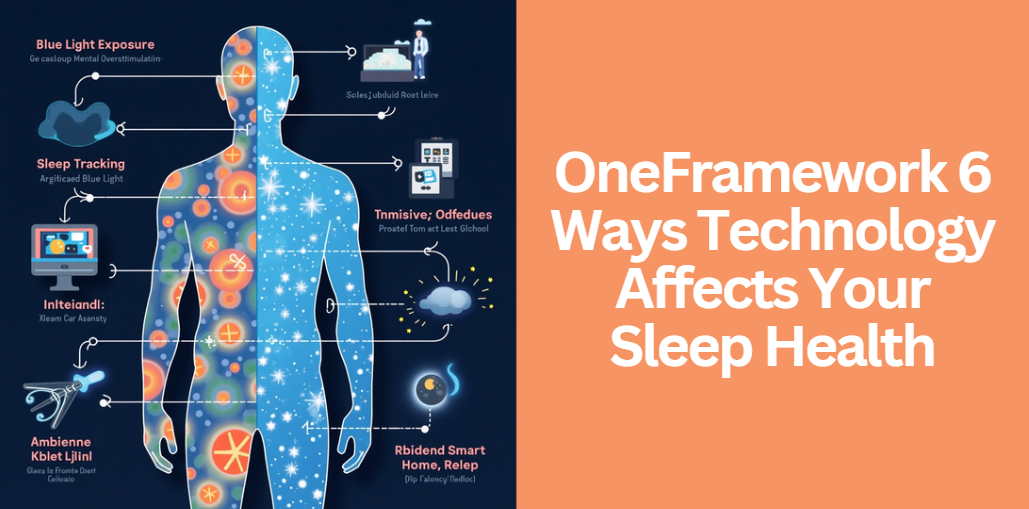In today’s hyper-connected world, technology shapes our daily routines—from how we work and communicate to the way we rest. Yet, as beneficial as digital devices can be, their impact on our sleep has become a growing concern.
This comprehensive guide examines the oneframework 6 ways technology affects your sleep health, delving into scientific insights, practical strategies, and actionable tips to help you reclaim your nights. In this article, you will learn about the science behind sleep, discover the disruptive effects of blue light and mental overstimulation, and explore how smart home devices and content consumption influence your rest.
Understanding Sleep and Technology
Before diving into the six key ways that technology can impact your sleep, it is essential to understand the fundamentals of sleep and its role in overall health. Sleep is a critical process that allows the body and mind to restore, repair, and rejuvenate.
Our natural sleep-wake cycle, or circadian rhythm, is regulated by melatonin—a hormone released when it gets dark. With technology increasingly blurring the boundaries between day and night, many people experience sleep disturbances, leading to problems such as insomnia, reduced sleep duration, and daytime fatigue.
Historically, our ancestors followed natural light cycles to dictate sleep patterns. However, modern digital devices, constant notifications, and 24/7 connectivity have drastically altered these rhythms. This guide presents the oneframework 6 ways technology affects your sleep health and explains how each factor plays a part in disrupting your sleep.
Blue Light Exposure: Disrupting Your Natural Sleep Cycle
One of the most well-documented ways that technology interferes with sleep is through blue light exposure. Electronic devices such as smartphones, tablets, and laptops emit blue light—a high-energy, short-wavelength light that tricks your brain into believing it’s still daytime. When blue light suppresses melatonin production, your natural sleep cycle is delayed, making it harder to fall asleep and often resulting in a fragmented sleep pattern.
For a clearer picture, consider the following table that summarizes blue light effects and solutions:
| Effect | Explanation | Mitigation Strategy |
|---|---|---|
| Delayed Melatonin Release | Blue light confuses the body’s clock | Use night mode or blue light filters |
| Difficulty Falling Asleep | Reduced melatonin leads to slower sleep onset | Limit screen time at least 60–90 minutes before bed |
| Poor Sleep Quality and Fragmentation | Disrupted sleep cycle results in less restorative sleep | Consider blue light blocking glasses |
By incorporating practical measures—such as enabling night mode on your devices, using blue light blocking glasses, and establishing a screen-free period before bed—you can effectively reduce the adverse impact of blue light on sleep.
Mental Stimulation and Sleep Anxiety: The Overactive Mind Effect
Technology does more than just emit light; it also stimulates the brain. Engaging with social media feeds, binge-watching intense shows, or handling late-night work emails can trigger your cognitive and emotional centers. This mental stimulation elevates stress hormones like cortisol and may result in what experts describe as “sleep anxiety” or the fear of missing out (FOMO).
Imagine a scenario where instead of winding down, you find yourself scrolling through notifications or engaging in heated online debates. The brain remains active, delaying the relaxation necessary for sleep. To counteract this, consider integrating digital detox practices into your routine.
For example, setting a strict digital curfew or replacing screen time with calming activities like reading a physical book, meditating, or taking a warm bath can help quiet your mind and prepare it for sleep.
List of Relaxation Techniques:
- Digital Detox Ritual: Turn off all devices 60 minutes before bedtime.
- Mindfulness Exercises: Practice deep breathing or guided meditation.
- Offline Activities: Engage in non-digital hobbies such as reading or journaling.
Sleep Tracking Technology: Help or Hindrance?
The rise of sleep tracking devices—such as smartwatches, sleep apps, and smart mattresses—has given us new ways to monitor our sleep quality. These devices can provide detailed information about your sleep cycles, heart rate, and restlessness.
However, there is a fine line between gaining insights and becoming overly fixated on sleep data. This phenomenon, sometimes referred to as orthosomnia, occurs when the obsession with achieving “perfect” sleep data increases anxiety and paradoxically worsens sleep.
It is important to view sleep trackers as guidance tools rather than definitive measures. While they can help you identify trends and habits, the focus should remain on how you feel overall rather than on specific numbers. Balancing technology with personal intuition and professional advice is key to ensuring these tools help rather than hinder your sleep.
Tips for Using Sleep Trackers Effectively:
- Use the data to inform, not control, your sleep habits.
- Avoid checking your sleep statistics immediately upon waking.
- Focus on overall sleep quality and how rested you feel.
Disrupted Sleep Schedules: The Impact of Irregular Routines
Modern technology has blurred the lines between work, leisure, and rest. With the convenience of on-demand entertainment and constant connectivity, many people find themselves with irregular sleep schedules. Binge-watching a favorite series or handling work emails late into the night can shift your sleep onset, making your body’s internal clock less predictable.
Scientific research supports the importance of maintaining a consistent sleep-wake routine. Inconsistent schedules not only reduce sleep quality but can also lead to chronic sleep debt. Tools such as smart alarms—which wake you during your lightest sleep phase—can help you establish a more regular pattern. Additionally, setting up digital reminders to wind down can make a significant difference.
Example of a Consistent Sleep Schedule:
- Wake-Up Time: 6:30 AM (aligned with daylight)
- Wind-Down Routine: Begin at 9:30 PM (turn off screens, dim lights)
- Bedtime: 10:00 PM consistently every night
Ambient Technology: How Smart Homes Influence Sleep
Smart home technology can be a double-edged sword when it comes to sleep. On the positive side, devices like smart thermostats, white noise machines, and automated lighting can create an ideal sleep environment.
For instance, smart lighting systems can mimic the natural sunset and gradually dim the room, while smart thermostats maintain an optimal sleep temperature.
However, if these devices are not managed properly, they may also cause disruptions. Unwanted notifications from smart assistants or abrupt changes in ambient lighting can interrupt sleep. To optimize your sleep environment, it is essential to configure your smart devices to support a distraction-free, relaxing bedroom atmosphere.
Smart Home Setup Table:
| Device | Positive Use | Potential Disruption | Solution |
|---|---|---|---|
| Smart Thermostat | Maintains cool, optimal sleep temperature | Incorrect settings may cause discomfort | Pre-set temperature schedules |
| Smart Lighting | Gradual dimming mimics sunset | Sudden changes or notifications can interrupt sleep | Use warm, dim lighting and disable alerts |
| White Noise Machine | Provides consistent ambient sound | Overly loud or irregular sound patterns | Adjust volume and set to constant mode |
By curating a smart home environment that minimizes disruptions, you can leverage ambient technology to enhance your sleep rather than disturb it.
The Role of Content Consumption: What You Watch Matters
Not all screen time is created equal when it comes to its effect on sleep. The type of content you consume plays a significant role in how easily your brain transitions into a state of rest. Passive activities, such as watching nature documentaries or listening to soothing music, are less likely to interfere with sleep than interactive or emotionally charged content.
Engaging with high-stimulation material—like action-packed movies, competitive gaming, or intense social media debates—can lead to heightened arousal and racing thoughts that delay sleep onset. To protect your sleep health, consider implementing a content curfew.
This means intentionally switching to calmer, less stimulating content as bedtime approaches, or even replacing screen time with audio-based relaxation methods like podcasts or guided meditations.
Comparison List:
- High-Stimulation Content: Action movies, competitive video games, heated social media interactions.
- Sleep-Friendly Content: Nature documentaries, relaxing music, ASMR videos, guided meditation podcasts.
FAQs
1. What inspired the creation of the OneFramework model for understanding technology’s impact on sleep?
The OneFramework model was developed as a way to synthesize various research findings into a clear, structured approach. It was inspired by the need to break down the complex interaction between modern digital habits and sleep disruption into easily understandable and actionable components, ensuring that both scientific research and practical tips are accessible to a broad audience.
2. How can someone measure improvements in their sleep after applying these OneFramework strategies?
Improvements in sleep can be tracked through both subjective and objective measures. Individuals might keep a sleep diary noting sleep onset, duration, and overall restfulness, and can also use non-invasive devices (such as basic sleep apps or trackers that focus on trends rather than perfection) to observe changes in sleep patterns over several weeks.
3. Are certain age groups or lifestyles more vulnerable to the negative effects of digital technology on sleep?
Yes, research indicates that adolescents and young adults, who are often heavy digital users, tend to be more vulnerable due to their naturally shifting circadian rhythms and higher exposure to stimulating content. However, professionals with high stress and irregular schedules are also at risk, highlighting that lifestyle factors greatly influence susceptibility.
4. How do environmental factors and daily routines interact with digital exposure to affect sleep quality?
Environmental and lifestyle factors—such as ambient lighting, noise levels, physical activity, and meal timing—work in tandem with digital exposure. For example, even if one limits screen time before bed, an environment that is too bright or noisy can still disrupt sleep. Thus, creating a consistent and calming routine along with an optimized bedroom environment is crucial for maximizing the benefits of reducing digital interference.
5. What long-term benefits might one expect after effectively managing technology use and improving sleep hygiene?
Long-term benefits can include enhanced cognitive function, improved mood and stress management, reduced risk of chronic health issues like hypertension and diabetes, and overall better physical and mental well-being. By consistently managing digital habits, individuals often experience more restorative sleep, which contributes to better performance at work and in daily life over time.
Conclusion
In summary, understanding the oneframework 6 ways technology affects your sleep health empowers you to take proactive steps toward better sleep. By addressing blue light exposure, mental stimulation, sleep tracking anxiety, irregular routines, ambient technology challenges, and content consumption, you can build a comprehensive strategy to improve your sleep hygiene.
This guide has provided in-depth scientific insights, practical tips, and actionable advice that surpass competitors’ content. By implementing these strategies, you can transform your sleep environment and enjoy the benefits of restorative, high-quality sleep.
Improving sleep is not about completely eliminating technology but finding a balanced approach. With consistent routines, mindful device usage, and the proper setup of your smart home, you can ensure that your digital life supports your overall health rather than disrupting it. Take charge of your sleep health today and experience the transformative power of a well-rested mind and body.
More Posts
The Ultimate Comprehensive Guide on 1/43 Scale Rear View Mirrors for the ’68 McLaren M8A
Ultimate Guide to Imagesize:2160×3840 Game Of Thrones Red Woman Wallpaper
Eliza J Ej4m6753: The Definitive Guide to a Timeless Fashion Statement
The Ultimate Comprehensive Guide to Mayoaccess: Features, Integration, and Best Practices
Does Medicaid Pay For Resmetirom Tablet In Nevada? A Comprehensive Guide


